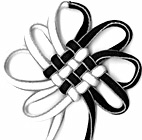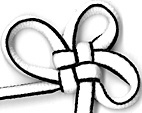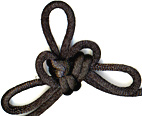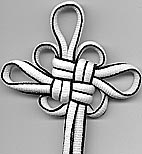AutoPage for Tag nomenclature Page 1 of 1
This page is automagically created and paginated for each tag available in the posts on this site

 In the next post, I’ll illustrate the relationship, but for now let me just say that the square form of the flower knot (see right) is the basic unit of the mystic knot (see left). The Ashley Book of Knots (also known as Ashley’s or ABoK) has much to say on the topic of mystic knots, but not in those words (Ashley calls this knot family the Chinese butterfly knots), so let’s extract them and put them in one post for easy reference, shall we? I’m making pronouncements based on visual inspection and could easily be wrong, I’ll tie them and post the pictures later, correcting as I go if necessary…
In the next post, I’ll illustrate the relationship, but for now let me just say that the square form of the flower knot (see right) is the basic unit of the mystic knot (see left). The Ashley Book of Knots (also known as Ashley’s or ABoK) has much to say on the topic of mystic knots, but not in those words (Ashley calls this knot family the Chinese butterfly knots), so let’s extract them and put them in one post for easy reference, shall we? I’m making pronouncements based on visual inspection and could easily be wrong, I’ll tie them and post the pictures later, correcting as I go if necessary…
Read more
 The mystic knot is the pan chang knot is the endless knot and is also less commonly known as the coil knot and the temple knot. Pan chang is, of course, the romanization of the Chinese name. The best literal translation of pan chang is probably coil, but the word evokes a much different image for most, I would suspect.
The mystic knot is the pan chang knot is the endless knot and is also less commonly known as the coil knot and the temple knot. Pan chang is, of course, the romanization of the Chinese name. The best literal translation of pan chang is probably coil, but the word evokes a much different image for most, I would suspect.
Read more
 I’ve been thinking of the whole 3 sided versus three (knot type or 6-eared and 6 petals and whatnot. Something like 3-luck is certainly good for quick file naming and shorthand, but in descriptive text when trying to be clear and unambiguous, I’m thinking to use full-on mathematical (polygonal) terminology. Especially since, as demonstrated by the case of the good luck knots the number of ears does not necessarily properly describe a many-sided knot. So all those 4-sided good luck knots I’ve been talking about they’re all square even when they look round. sigh
I’ve been thinking of the whole 3 sided versus three (knot type or 6-eared and 6 petals and whatnot. Something like 3-luck is certainly good for quick file naming and shorthand, but in descriptive text when trying to be clear and unambiguous, I’m thinking to use full-on mathematical (polygonal) terminology. Especially since, as demonstrated by the case of the good luck knots the number of ears does not necessarily properly describe a many-sided knot. So all those 4-sided good luck knots I’ve been talking about they’re all square even when they look round. sigh
But in any case, because pictures make a blog infinitely more interesting, here’s the triangular good luck knot. Nothing tricky here, just make a ‘Y’ shape with bights and crown it twice. Reverse direction for the second crown for a crisper shape.

 The good luck knot (吉祥結), a name coined by Lydia Chen who wrote the seminal book Chinese Knotting in both Chinese and English, is based on the crown knot. Usually the crown knot is tied in sequence to create a sinnet, a braid composed of knots. The best static (not animated) instructions I have found on the net for the crown sinnets are by The Boondoggle Man who, unfortunately, calls them the square stitch and the circle stitch.
The good luck knot (吉祥結), a name coined by Lydia Chen who wrote the seminal book Chinese Knotting in both Chinese and English, is based on the crown knot. Usually the crown knot is tied in sequence to create a sinnet, a braid composed of knots. The best static (not animated) instructions I have found on the net for the crown sinnets are by The Boondoggle Man who, unfortunately, calls them the square stitch and the circle stitch.
Read more

 In the next post, I’ll illustrate the relationship, but for now let me just say that the square form of the flower knot (see right) is the basic unit of the mystic knot (see left). The Ashley Book of Knots (also known as Ashley’s or ABoK) has much to say on the topic of mystic knots, but not in those words (Ashley calls this knot family the Chinese butterfly knots), so let’s extract them and put them in one post for easy reference, shall we? I’m making pronouncements based on visual inspection and could easily be wrong, I’ll tie them and post the pictures later, correcting as I go if necessary…
In the next post, I’ll illustrate the relationship, but for now let me just say that the square form of the flower knot (see right) is the basic unit of the mystic knot (see left). The Ashley Book of Knots (also known as Ashley’s or ABoK) has much to say on the topic of mystic knots, but not in those words (Ashley calls this knot family the Chinese butterfly knots), so let’s extract them and put them in one post for easy reference, shall we? I’m making pronouncements based on visual inspection and could easily be wrong, I’ll tie them and post the pictures later, correcting as I go if necessary…

